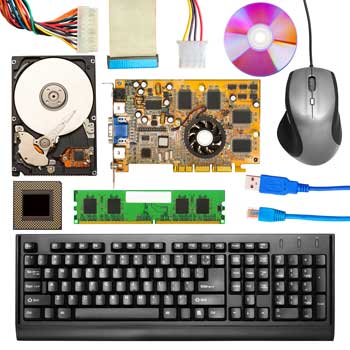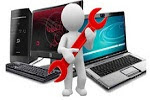Computer Hardware
Computer hardware is the collection of physical parts of a computer system. This includes the computer case, monitor, keyboard, and mouse. It also includes all the parts inside the computer case, such as the hard disk drive, motherboard, video card, and many others. Computer hardware is what you can physically touch.
Definitions
A computer system consists of two major elements: hardware and software. Computer hardware is the collection of all the parts you can physically touch. Computer software, on the other hand, is not something you can touch. Software is a set of instructions for a computer to perform specific operations. You need both hardware and software for a computer system to work.
Some hardware components are easy to recognize, such as the computer case, keyboard, and monitor. However, there are many different types of hardware components. In this lesson, you will learn how to recognize the different components and what they do.
Types of Computers
Before looking at the various components, it is useful to distinguish between two different types of computers: desktop computers and laptop computers. A desktop computer consists of a computer case and a separate monitor, keyboard, and mouse. As the name suggests, this type of computer is typically placed on a desk and is not very portable.
 |
A laptop computer has the same components but integrated into a single, portable unit.
 |
While these two types of computers look quite different, they have the same general hardware components.
Hardware Components
Let's start with the computer case. This is the metal enclosure that contains many of the other hardware components. It comes in various shapes and sizes, but a typical tower model is between 15-25 inches high. Want to know what's inside? Okay, go get a screwdriver and let's open it up. Seriously, if you are really into computers, the best way to learn is to actually get hands-on. To save us some time, however, have a look at this desktop computer case. A computer enthusiast replaced the metal side panel with a transparent one, so we can have a look inside.
Although that photo looks pretty cool, it is a bit hard to recognize the individual components, especially with all the connecting wires running through it. This figure shows a more schematic version of a desktop computer, which makes it easier
Hardware represents the physical and tangible components of a computer, i.e. the components that can be seen and touched.
Examples of Hardware are the following −
- Input devices − keyboard, mouse, etc.
- Output devices − printer, monitor, etc.
- Secondary storage devices − Hard disk, CD, DVD, etc.
- Internal components − CPU, motherboard, RAM, etc.

Relationship between Hardware and Software
- Hardware and software are mutually dependent on each other. Both of them must work together to make a computer produce a useful output.
- Software cannot be utilized without supporting hardware.
- Hardware without a set of programs to operate upon cannot be utilized and is useless.
- To get a particular job done on the computer, relevant software should be loaded into the hardware.
- Hardware is a one-time expense.
- Software development is very expensive and is a continuing expense.
- Different software applications can be loaded on a hardware to run different jobs.
- A software acts as an interface between the user and the hardware.
- If the hardware is the 'heart' of a computer system, then the software is its 'soul'. Both are complementary to each other.
Computer Parts and Hardware Guide
Introduction
Assembling a desktop or server workstation can be an easy and straightforward process, provided that you have all the necessary computer parts. There are several advantages to building a computer in-house, including potentially lower costs and more customizability. Below, NeweggBusiness will outline various computer parts that will be needed to assemble a system.
Computer Parts
Processors
The processor directly affects overall computer performance, more than other components such as the sound card or power supply.
When selecting a processor, some important considerations include the number of cores, the clock speed of those cores, and the amount of cache memory.
Motherboards
The motherboard is the component that unifies the internal hardware. You will need to ensure that the processor, memory, and other computer parts are compatible with the motherboard.
Though the motherboard can affect system performance, it can be difficult to quantify how much of an impact it has. Several important considerations include, the maximum amount of memory supported, compatible processors, data interface standards, and expansion card slots.
Random Access Memory (RAM)
Both the amount and speed of memory are quantifiable factors that directly affect computer performance. Generally, the more memory a computer has, the better it will be able to multitask. Faster memory can speed up tasks that require data to be frequently loaded and retrieved.
Computer Cases
There are many different types of computer cases, from small portable ITX cases to larger E-ATX cases for servers and workstations.
When selecting a case, you should consider how and where the computer will be used. Also, determine if the case’s internal dimensions are adequate for the components that you plan to use.
Power Supply Unit (PSU)
Computer power supplies are components that connect to an electrical outlet and send power to the individual computer parts. When selecting a power supply, you will need to determine if can handle the total power requirement of all the components.
To do that, add up the power loads of all the internal components and ensure that the PSU can supply at least that much power. It is recommended that you choose a power supply well above that minimum for more flexibility.
Hard Drives
The hard drive is a data storage device that can be used to store the operating system, programs, documents, and other important files. When selecting a hard drive, ensure that it is compatible with the motherboard as well as being large and quick enough for your needs.
Alternatively, you can use a solid state drive for increased data transfer speeds, lower noise output, and better energy efficiency.
Video Cards
A video card is a required component, but many motherboards already have one built-in. However, some tasks may require the use of a dedicated video card even if the motherboard has onboard video capabilities. Tasks such as 3D rendering and simulation can sometimes require the use of workstation-grade video cards.
Network Adapters
While not required for the computer to be used, network connectivity is necessary for internet and local area network (LAN) access. Some motherboards have network adapters built into them, so separate adapters are not always required.
There are two main types of network adapters, internal and external. Internal network adapters utilize expansion slots while external variants are usually USB.
Sound Cards
Many desktop motherboards have sound cards built-in, allowing for audio playback without the need for a dedicated sound card. However, the quality of these built-in sound cards is generally not on par with high-end dedicated sound cards. For tasks that require high definition audio playback, dedicated sound cards are usually better than onboard solutions.
Optical Drives
An optical drive is beneficial for many uses, including backing up data, installing software, and playing multimedia content. Before shopping for an optical drive however, you should check what type of data connector the motherboard utilizes and if any are available for use.
Conclusion
If a pre-assembled desktop or server workstation is not within your budget, assembling one in-house can be a lower cost alternative. For underperforming desktop computers, upgrading individual computer parts may be more cost-effective than replacing the entire system.

No comments